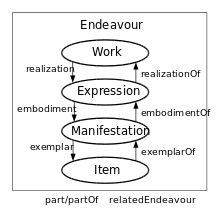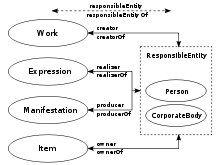Functional Requirements for Bibliographic Records
Functional Requirements for Bibliographic Records (FRBR /ˈfɜrbər/) is a conceptual entity-relationship model developed by the International Federation of Library Associations and Institutions (IFLA) that relates user tasks of retrieval and access in online library catalogues and bibliographic databases from a user’s perspective. It represents a more holistic approach to retrieval and access as the relationships between the entities provide links to navigate through the hierarchy of relationships. The model is significant because it is separate from specific cataloguing standards such as AACR2 or International Standard Bibliographic Description (ISBD).
FRBR entities


FRBR comprises groups of entities:
- Group 1 entities are work, expression, manifestation, and item (WEMI). They represent the products of intellectual or artistic endeavor.
- Group 2 entities are person, family and corporate body, responsible for the custodianship of Group 1’s intellectual or artistic endeavor.
- Group 3 entities are subjects of Group 1 or Group 2’s intellectual endeavor, and include concepts, objects, events, places.
Group 1 entities are the foundation of the FRBR model:
- Work is a "distinct intellectual or artistic creation."[1] For example, Beethoven's Ninth Symphony apart from all ways of expressing it is a work. When we say, "Beethoven's Ninth is magnificent!" we generally are referring to the work.
- Expression is "the specific intellectual or artistic form that a work takes each time it is 'realized.'"[1] An expression of Beethoven's Ninth might be each draft of the musical score he writes down (not the paper itself, but the music thereby expressed).
- Manifestation is "the physical embodiment of an expression of a work. As an entity, manifestation represents all the physical objects that bear the same characteristics, in respect to both intellectual content and physical form."[1] The performance the London Philharmonic made of the Ninth in 1996 is a manifestation. It was a physical embodiment even if not recorded, though of course manifestations are most frequently of interest when they are expressed in a persistent form such as a recording or printing. When we say, "The recording of the London Philharmonic's 1996 performance captured the essence of the Ninth," we are generally referring to a manifestation.
- Item is "a single exemplar of a manifestation. The entity defined as item is a concrete entity."[1] Each copy of the 1996 pressings of that 1996 recording is an item. When we say, "Both copies of the London Philharmonic's 1996 performance of the Ninth are checked out of my local library," we are generally referring to items.
Relationships
FRBR is built upon relationships between and among entities. "Relationships serve as the vehicle for depicting the link between one entity and another, and thus as the means of assisting the user to ‘navigate’ the universe that is represented in a bibliography, catalogue, or bibliographic database."[2] Examples of relationship types include, but are not limited to:[3]
Equivalence relationships
Equivalence relationships exist between exact copies of the same manifestation of a work or between an original item and reproductions of it, so long as the intellectual content and authorship are preserved. Examples include reproductions such as copies, issues, facsimiles and reprints, photocopies, and microfilms.
Derivative relationships
Derivative relationships exist between a bibliographic work and a modification based on the work. Examples include:
- Editions, versions, translations, summaries, abstracts, and digests
- Adaptations that become new works but are based on old works
- Genre changes
- New works based on the style or thematic content of the work
Descriptive relationships
Descriptive relationships exist between a bibliographic entity and a description, criticism, evaluation, or review of that entity, such as between a work and a book review describing it. Descriptive relationships also includes annotated editions, casebooks, commentaries, and critiques of an existing work.
See also
References
- ↑ 1.0 1.1 1.2 1.3 "Functional Requirements for Bibliographic Records - Final Report - Part 1". ifla.org. Retrieved 15 April 2014.
- ↑ "Functional Requirements for Bibliographic Records - Final Report - Part 2". ifla.org. Retrieved 15 April 2014.
- ↑ International Federation of Library Associations and Institutions. "Functional Requirements for Bibliographic Records: Final Report". Retrieved 3 December 2013.
Further reading
- IFLA Study Group on the Functional Requirements for Bibliographic Records. Functional requirements for bibliographic records : final report. — München: K.G. Saur, 1998. — (UBCIM publications ; new series, vol. 19). — ISBN 3-598-11382-X. (Accessed Nov. 6, 2005)
- Madison, Olivia M.A. (July 2000). "The IFLA Functional Requirements for Bibliographic Records: International Standards for Universal Bibliographic Control". Library Resources and Technical Services. 3 44: 153–159. Retrieved 16 February 2013.
- Tillett, Barbara. FRBR: A Conceptual Model for the Bibliographic Universe. Library of Congress Cataloging Distribution Service, 2004. (Accessed Nov. 6, 2005)
External links
- RDA: Resource Description and Access
- The FRBR Blog: A weblog following developments around the world in FRBR
- Functional Requirements for Bibliographic Records, International Federation of Library Associations and Institutions
- RDA Blog